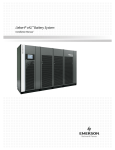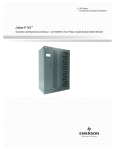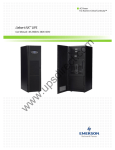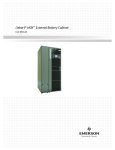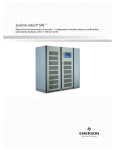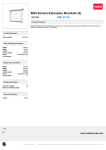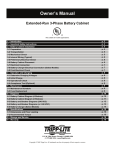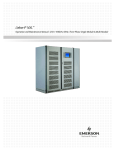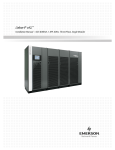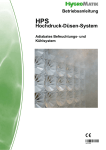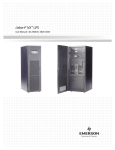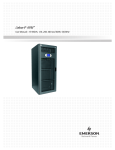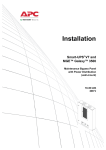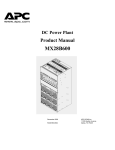Download Emerson Liebert NX Battery System User's Manual
Transcript
AC Power For Business-Critical Continuity™ Liebert® NX™ Battery System Installation Manual–225-600kVA BATTERY CABINET PRECAUTIONS The following warning applies to all battery cabinets supplied with UPS systems. Additional warnings and cautions applicable to battery cabinets may be found in Important Safety Instructions beginning on page 1. ! WARNING Internal battery strapping must be verified prior to moving a battery cabinet (after initial installation). • Battery cabinets contain non-spillable batteries. • Keep units upright. • Do not stack. • Do not tilt. Failure to heed this warning could result in smoke, fire or electric hazard. Call 1-800-LIEBERT prior to moving battery cabinets (after initial installation). CONTACTING LIEBERT FOR SUPPORT To contact Emerson Network Power Liebert Services for information or repair service in the United States, call 1-800-LIEBERT (1-800-543-2378). Liebert Services offers a complete range of startup services, repair services, preventive maintenance plans and service contracts. For repair or maintenance service outside the 48 contiguous United States, contact Liebert Services, if available in your area. For Liebert Services to assist you promptly, have the following information available: Part Numbers: Serial Numbers: Rating: Date Purchased: Date Installed: Location: Battery Voltage: Battery Reserve Time: Product Warranty Registration To register for warranty protection, visit the Service and Support section of our Web site at: www.liebert.com Click on Product Registration and fill out the form. TABLE OF CONTENTS IMPORTANT SAFETY INSTRUCTIONS . . . . . . . . . . . . . . . . . . . . . . . . . . . . . . . . . . . . . . . . . . . . . . . .1 SAVE THESE INSTRUCTIONS . . . . . . . . . . . . . . . . . . . . . . . . . . . . . . . . . . . . . . . . . . . . . . . . .1 1.0 MECHANICAL INSTALLATION . . . . . . . . . . . . . . . . . . . . . . . . . . . . . . . . . . . . . . . . . . . . . . . .3 1.1 Introduction . . . . . . . . . . . . . . . . . . . . . . . . . . . . . . . . . . . . . . . . . . . . . . . . . . . . . . . . . . . . . . . . 3 1.2 Preliminary Checks . . . . . . . . . . . . . . . . . . . . . . . . . . . . . . . . . . . . . . . . . . . . . . . . . . . . . . . . . . 3 1.3 Environmental Considerations . . . . . . . . . . . . . . . . . . . . . . . . . . . . . . . . . . . . . . . . . . . . . . . . . 3 1.3.1 1.3.2 1.4 Battery Room . . . . . . . . . . . . . . . . . . . . . . . . . . . . . . . . . . . . . . . . . . . . . . . . . . . . . . . . . . . . . . . . 3 Storage . . . . . . . . . . . . . . . . . . . . . . . . . . . . . . . . . . . . . . . . . . . . . . . . . . . . . . . . . . . . . . . . . . . . . 3 Positioning . . . . . . . . . . . . . . . . . . . . . . . . . . . . . . . . . . . . . . . . . . . . . . . . . . . . . . . . . . . . . . . . . 4 1.4.1 1.4.2 1.4.3 Moving the Cabinets. . . . . . . . . . . . . . . . . . . . . . . . . . . . . . . . . . . . . . . . . . . . . . . . . . . . . . . . . . . 4 Clearances. . . . . . . . . . . . . . . . . . . . . . . . . . . . . . . . . . . . . . . . . . . . . . . . . . . . . . . . . . . . . . . . . . . 5 Raised Floor Mounting . . . . . . . . . . . . . . . . . . . . . . . . . . . . . . . . . . . . . . . . . . . . . . . . . . . . . . . . . 5 1.5 System Composition . . . . . . . . . . . . . . . . . . . . . . . . . . . . . . . . . . . . . . . . . . . . . . . . . . . . . . . . . . 5 2.0 BATTERY INSTALLATION . . . . . . . . . . . . . . . . . . . . . . . . . . . . . . . . . . . . . . . . . . . . . . . . . . .6 2.1 Safety . . . . . . . . . . . . . . . . . . . . . . . . . . . . . . . . . . . . . . . . . . . . . . . . . . . . . . . . . . . . . . . . . . . . . 6 2.2 Layout . . . . . . . . . . . . . . . . . . . . . . . . . . . . . . . . . . . . . . . . . . . . . . . . . . . . . . . . . . . . . . . . . . . . . 6 2.3 Cable Entry. . . . . . . . . . . . . . . . . . . . . . . . . . . . . . . . . . . . . . . . . . . . . . . . . . . . . . . . . . . . . . . . . 8 2.4 Power Connection . . . . . . . . . . . . . . . . . . . . . . . . . . . . . . . . . . . . . . . . . . . . . . . . . . . . . . . . . . . . 8 2.4.1 2.4.2 2.4.3 2.4.4 Connected System . . . . . . . . . . . . . . . . . . . . . . . . . . . . . . . . . . . . . . . . . . . . . . . . . . . . . . . . . . . . Stand-Alone System . . . . . . . . . . . . . . . . . . . . . . . . . . . . . . . . . . . . . . . . . . . . . . . . . . . . . . . . . . Attached/Detached System . . . . . . . . . . . . . . . . . . . . . . . . . . . . . . . . . . . . . . . . . . . . . . . . . . . . . Grounding . . . . . . . . . . . . . . . . . . . . . . . . . . . . . . . . . . . . . . . . . . . . . . . . . . . . . . . . . . . . . . . . . . . 8 8 8 9 2.5 Control Connection. . . . . . . . . . . . . . . . . . . . . . . . . . . . . . . . . . . . . . . . . . . . . . . . . . . . . . . . . . . 9 2.6 Alber Monitoring System—Optional . . . . . . . . . . . . . . . . . . . . . . . . . . . . . . . . . . . . . . . . . . . . 10 2.7 External Battery Room Temperature Sensor—Optional . . . . . . . . . . . . . . . . . . . . . . . . . . . . 10 3.0 INSTALLATION DRAWINGS . . . . . . . . . . . . . . . . . . . . . . . . . . . . . . . . . . . . . . . . . . . . . . . . . 11 4.0 SPECIFICATIONS . . . . . . . . . . . . . . . . . . . . . . . . . . . . . . . . . . . . . . . . . . . . . . . . . . . . . . . .28 i FIGURES Figure 1 Figure 2 Figure 3 Figure 4 Figure 5 Figure 6 Figure 7 Figure 8 Figure 9 Figure 10 Figure 11 Figure 12 Figure 13 Figure 14 Figure 15 Figure 16 Figure 17 Figure 18 Figure 19 Figure 20 Figure 21 Figure 22 Figure 23 Figure 24 Shipping bolts—Top-Terminal Battery Cabinet . . . . . . . . . . . . . . . . . . . . . . . . . . . . . . . . . . . . . . . . 4 Battery cabinets connected, attached to UPS . . . . . . . . . . . . . . . . . . . . . . . . . . . . . . . . . . . . . . . . . . 7 Battery cabinets connected, detached from UPS . . . . . . . . . . . . . . . . . . . . . . . . . . . . . . . . . . . . . . . 7 Stand-alone battery cabinets, detached from UPS . . . . . . . . . . . . . . . . . . . . . . . . . . . . . . . . . . . . . . 8 Control cable layout—Liebert NX UPS to Liebert NX Battery Cabinet . . . . . . . . . . . . . . . . . . . . . 9 Battery temperature sensor control connection . . . . . . . . . . . . . . . . . . . . . . . . . . . . . . . . . . . . . . . 10 Outline drawing, Liebert Top-Terminal Battery Cabinet . . . . . . . . . . . . . . . . . . . . . . . . . . . . . . . 11 Main components, Liebert Top-Terminal Battery Cabinet . . . . . . . . . . . . . . . . . . . . . . . . . . . . . . 12 Terminal details, Liebert Top-Terminal Battery Cabinet . . . . . . . . . . . . . . . . . . . . . . . . . . . . . . . 13 Front Terminal Battery Cabinet shipping split . . . . . . . . . . . . . . . . . . . . . . . . . . . . . . . . . . . . . . . 14 Front Terminal Battery Cabinet outline drawing. . . . . . . . . . . . . . . . . . . . . . . . . . . . . . . . . . . . . . 15 Front Terminal Battery Cabinet main components, layout . . . . . . . . . . . . . . . . . . . . . . . . . . . . . . 16 Front Terminal detail drawing. . . . . . . . . . . . . . . . . . . . . . . . . . . . . . . . . . . . . . . . . . . . . . . . . . . . . 17 Liebert NX Stand-Alone Junction Cabinet terminal wiring . . . . . . . . . . . . . . . . . . . . . . . . . . . . . 18 Liebert NX Attached Junction Cabinet—terminal detail and outline drawing . . . . . . . . . . . . . . 19 Liebert NX Battery Cabinet control wiring . . . . . . . . . . . . . . . . . . . . . . . . . . . . . . . . . . . . . . . . . . . 20 Attached battery cabinet connections . . . . . . . . . . . . . . . . . . . . . . . . . . . . . . . . . . . . . . . . . . . . . . . 21 Ground strap location for connected cabinets . . . . . . . . . . . . . . . . . . . . . . . . . . . . . . . . . . . . . . . . . 21 Typical Alber battery monitoring connections . . . . . . . . . . . . . . . . . . . . . . . . . . . . . . . . . . . . . . . . 22 Alber battery monitoring wiring to multiple battery cabinets . . . . . . . . . . . . . . . . . . . . . . . . . . . . 23 Alber battery monitoring assembly diagram. . . . . . . . . . . . . . . . . . . . . . . . . . . . . . . . . . . . . . . . . . 24 Top-Terminal battery configuration . . . . . . . . . . . . . . . . . . . . . . . . . . . . . . . . . . . . . . . . . . . . . . . . 25 Front-Terminal battery configuration . . . . . . . . . . . . . . . . . . . . . . . . . . . . . . . . . . . . . . . . . . . . . . . 26 Busbar connection between Battery Cabinet and Attached Junction Cabinet . . . . . . . . . . . . . . . 27 TABLES Table 1 Table 2 Table 3 Table 4 Table 5 Table 6 Table 7 Table 8 Table 9 Table 10 Alber battery monitoring assembly connections . . . . . . . . . . . . . . . . . . . . . . . . . . . . . . . . . . . . . . . Liebert NX Battery Cabinet specifications . . . . . . . . . . . . . . . . . . . . . . . . . . . . . . . . . . . . . . . . . . . Liebert NX Junction Cabinet specifications . . . . . . . . . . . . . . . . . . . . . . . . . . . . . . . . . . . . . . . . . . Alber battery monitoring option specifications . . . . . . . . . . . . . . . . . . . . . . . . . . . . . . . . . . . . . . . . DC currents for Liebert NX modules . . . . . . . . . . . . . . . . . . . . . . . . . . . . . . . . . . . . . . . . . . . . . . . . Liebert NX Battery Cabinet internal breaker. . . . . . . . . . . . . . . . . . . . . . . . . . . . . . . . . . . . . . . . . Liebert NX Battery Cabinet approximate weights . . . . . . . . . . . . . . . . . . . . . . . . . . . . . . . . . . . . . Recommended conduit and cable sizes from Liebert NX UPS to DC supply. . . . . . . . . . . . . . . . . Battery torque values . . . . . . . . . . . . . . . . . . . . . . . . . . . . . . . . . . . . . . . . . . . . . . . . . . . . . . . . . . . . Torque specifications, unless otherwise labeled . . . . . . . . . . . . . . . . . . . . . . . . . . . . . . . . . . . . . . . ii 24 28 29 29 29 30 30 31 31 32 IMPORTANT SAFETY INSTRUCTIONS SAVE THESE INSTRUCTIONS This manual contains important instructions that should be followed during installation of your Liebert NX Battery Cabinet and accessories. Read this manual thoroughly, paying special attention to the sections that apply to your installation, before working with the battery system. Retain this manual for use by installing personnel. ! WARNING Risk of electrical shock. Can cause personal injury and death. Special safety precautions are required for procedures involving handling, installation and maintenance of the UPS system. Only properly trained and qualified personnel wearing appropriate personal protective equipment should be involved in installing the Liebert NX Battery system or preparing the system for installation. Special care must be taken when working with the batteries associated with this equipment. When connected together, the battery terminal voltage will exceed 400VDC and is potentially lethal. Be constantly aware that the battery system contains high DC as well as AC voltages. Check for voltage with AC and DC voltmeters before making contact. Observe all DC safety precautions before working on or near the DC system. Follow all battery safety precautions when installing, charging or servicing batteries. In addition to the hazard of electric shock, gas produced by batteries can be explosive and sulfuric acid can cause severe burns. The following precautions must be observed when working on batteries: • • • • • • Remove watches, rings and other metal objects. Use tools with insulated handles. Wear rubber gloves and boots. Do not lay tools or metal parts on top of batteries. Disconnect charging source prior to connecting or disconnecting battery terminals. Determine whether the battery is grounded. If it is grounded, remove source of ground. Contact with any part of a grounded battery can result in electrical shock. The likelihood of such shock will be reduced if such grounds are removed during installation and maintenance. If a battery leaks electrolyte, or is otherwise physically damaged, it must be replaced, stored in a container resistant to sulfuric acid and disposed of in accordance with local regulations. If electrolyte comes into contact with the skin, the affected area should be washed immediately with water. ! WARNING Risk of electric shock, explosive reaction, hazardous chemicals and fire. Can cause equipment damage, personal injury and death. Lead-acid batteries contain hazardous materials. Batteries must be handled, transported and recycled or discarded in accordance with federal, state and local regulations. Because lead is a toxic substance, lead-acid batteries must be recycled rather than discarded. Do not dispose of a battery in a fire. The battery may explode. Do not open or mutilate the battery or batteries. Released electrolyte is harmful to the skin and eyes. It is toxic. ! WARNING Risk of electric shock. Can cause personal injury and death. In case of fire involving electrical equipment, use only carbon dioxide fire extinguishers or those approved for use in fighting electrical fires. 1 Liebert® NX™ ! WARNING Risk of heavy unit falling over. Can cause equipment damage, injury and death. Exercise extreme care when handling battery cabinets to avoid equipment damage or injury to personnel. The battery system cabinets weigh from 3760 to 8990 lb. (1706 to 4078kg). Locate center of gravity symbols and determine unit weight before handling each cabinet. Test lift and balance the cabinets before transporting. Maintain minimum tilt from vertical at all times. Slots at the base of the cabinets are intended for forklift use. Base slots will support the unit only if the forks are completely beneath the unit. ! WARNING Risk of electric shock. Can cause equipment damage, personal injury and death. The area around the battery system must be kept free of puddles of water, excess moisture and debris. Observe all precautions in the Operation and Maintenance Manual, SL 25425, before as well as during all installation and maintenance procedures. Observe all battery safety precautions before working on or near the battery. This equipment contains several circuits that are energized with high voltage. Only test equipment designed for troubleshooting should be used. This is particularly true for oscilloscopes. Always check with an AC and DC voltmeter to ensure safety before making contact or using tools. Even when the power is turned Off, dangerously high potential electric charges may exist at the capacitor banks and at the batteries. All power and control wiring must be installed by a properly trained and qualified electrician. All power and control wiring must comply with the NEC and applicable local codes. When performing maintenance with any part of the equipment under power, service personnel and test equipment must be standing on rubber mats. The service personnel must wear insulating shoes for isolation from direct contact with the floor (earth ground). One person should never work alone, even if all power is disconnected from the equipment. A second person should be standing by to assist and to summon help in case of an accident. NOTE Materials sold hereunder cannot be used in the patient vicinity (e.g., use where UL, cUL or IEC 60601-1 is required). Medical applications such as invasive procedures and electrical life support equipment are subject to additional terms and conditions. NOTICE This unit complies with the limits for a Class A digital device, pursuant to Part 15 Subpart J of the FCC rules. These limits provide reasonable protection against harmful interference in a commercial environment. This unit generates, uses and radiates radio frequency energy and, if not installed and used in accordance with this instruction manual, may cause harmful interference to radio communications. Operation of this unit in a residential area may cause harmful interference that the user must correct at his own expense. Liebert® NX™ 2 Mechanical Installation 1.0 MECHANICAL INSTALLATION 1.1 Introduction This following section describes the requirements that must be taken into account when planning the positioning and cabling of the Liebert NX battery equipment. This chapter is a guide to general procedures and practices that should be observed by the installing engineer. The particular conditions of each site will determine the applicability of such procedures. NOTICE Do not apply electrical power to the UPS equipment before the arrival of the commissioning engineer. 1.2 Preliminary Checks Before installing the battery equipment, please carry out the following preliminary checks: • Visually examine the equipment for transit damage, both internally and externally. Report any damage to the shipper immediately. • Verify that the correct equipment is being installed. The equipment supplied has an identification tag inside the main door. • Verify that the battery room satisfies the environmental conditions stipulated in the equipment specification, paying particular attention to the ambient temperature and air exchange system. 1.3 Environmental Considerations 1.3.1 Battery Room Batteries should be mounted in an environment where the temperature is consistent and even over the whole battery. Temperature is a major factor in determining the battery life and capacity. Typical battery manufacturer performance data are quoted for an operating temperature between 68 and 77°F (20 and 25°C). Operating above this range will reduce the battery life while operation below this range will reduce the battery capacity. Battery Temperature In a normal installation, the battery temperature should be kept between 59 and 77°F (15°C and 25°C). NOTE Keep batteries away from main heat sources, main air inlets, etc. 1.3.2 Storage Should the equipment not be installed immediately, it must be stored in a room for protection against excessive humidity and heat sources (see Table 2). NOTICE Risk of deep discharge. Can cause permanent damage to batteries. An unused battery must be recharged periodically as recommended by the battery manufacturer. 3 Liebert® NX™ Mechanical Installation 1.4 Positioning The cabinet is structurally designed to handle lifting from the base. Power terminals, auxiliary terminals blocks and power switches are accessed from the front and top. Removable panels on the top are secured to the chassis by screws. The door can be opened to give access to the power connections bars, auxiliary terminal blocks and power isolators. The front door can be opened 180° for easier service and more flexibility in installation. 1.4.1 Moving the Cabinets The route to be travelled between the point of arrival and the unit’s installation location must be planned to make sure that all passages are wide enough for the unit and that floors are capable of supporting its weight (for instance, check that doorways, lifts, ramps, etc., are adequate and that there are no impassable corners or changes in the level of corridors). Ensure that the cabinet weight is within the designated surface weight loading (kg/cm2) of any handling equipment. See Table 2 for weight details. Ensure that any lifting equipment used to move the battery equipment has sufficient lifting capacity. Battery system equipment can be handled by a forklift or similar equipment. Because the weight distribution in the cabinet is not symmetrical, use extreme care during handling and transporting. When moving the unit by forklift, care must be taken to protect the panels. Do not exceed a 15° tilt with the forklift. Bottom structure will support the unit only if the forks are completely beneath the unit. Handling the unit with straps is not authorized. ! WARNING Risk of heavy unit falling over. Can cause equipment damage, injury and death. Exercise extreme care when handling battery cabinets. The battery system cabinets weigh from 3760 to 8990 lb. (1706 to 4078kg). Locate center of gravity symbols and determine unit weight before handling each cabinet. Test lift and balance the cabinets before transporting. Maintain minimum tilt from vertical at all times. Slots at the base of the cabinets are intended for forklift use. Base slots will support the unit only if the forks are completely beneath the unit. The cabinet with top terminal batteries ships with extra bolts installed on the interior doors. Once the cabinet is in the final position, these bolts can be removed. See Figure 1 Figure 1 Shipping bolts—Top-Terminal Battery Cabinet Shipping Bolts Shipping Bolts Shipping Bolts * Outer doors removed for clarity Shipping Bolts Shipping Bolts Shipping Bolts Shipping Shipping Bolts Bolts Liebert® NX™ 4 Mechanical Installation 1.4.2 Clearances Liebert NX has no ventilation grilles at either side or at the rear of the battery system equipment. Clearance around the front of the equipment should be sufficient to enable free passage of personnel with the doors fully opened. It is important to leave a distance of 24" (610mm) between the top of the cabinet and the ceiling of the room in which it is installed to permit adequate circulation of air coming out of the unit and for service access. 1.4.3 Raised Floor Mounting If the equipment is to be placed on a raised floor, it should be mounted on a pedestal suitably designed to accept the equipment point loading. Refer to the base view to design this pedestal. 1.5 System Composition A battery system can consist of a number of equipment cabinets, depending on the individual system design requirements, e.g., Battery Cabinet, Junction Cabinet. Refer to 3.0 - Installation Drawings for the positioning of the cabinets described below. 5 Liebert® NX™ Battery Installation 2.0 BATTERY INSTALLATION 2.1 Safety Special care should be taken when working with the batteries associated with the Liebert NX Battery System equipment. When all the cells are connected together, the battery terminal voltage will exceed 400V and is potentially lethal. A primary safety consideration is to install the battery equipment in an isolated area, accessible only to properly trained and qualified maintenance personnel. ! WARNING Risk of electric shock. Can cause equipment damage, personal injury and death. Hazardous battery voltage present behind covers. No user-serviceable parts are located behind covers that require a tool for removal. Only properly trained and qualified service personnel are authorized to remove such covers or perform installation or maintenance. The following general battery safety precautions and warnings must be observed at all times: • A battery can present risk of electric shock or burn from high short circuit currents. • When connected in a string, the voltage will exceed 400VDC. This voltage is potentially lethal. Always observe high-voltage precautions. • Eye protection must be worn to prevent injury from accidental electrical arcs. • Remove rings, watches, necklaces, bracelets and all other metal objects. • Use only tools with insulated handles. • Wear appropriate personal protective equipment when handling batteries. • If a battery leaks electrolyte or is otherwise physically damaged, it should be placed in a container resistant to wire and disposed of in accordance with local regulations. • If electrolyte comes into contact with the skin, the affected area should be washed immediately with plenty of clean water. • Batteries must always be disposed of according to local environmental laws. • When replacing batteries, use the same number and type that were originally fitted. • Disconnect charging source prior to connecting or disconnecting battery terminals. • Determine if the battery is grounded. If it is grounded, remove source of ground. Contact with any part of a grounded battery can result in electrical shock. • Battery support tray must be used whenever a battery tray is being pulled out. 2.2 Layout Depending on the site layout, the battery cabinets can be installed in any of several ways: • • • • Connected—Multiple battery cabinets bolted together Stand-Alone—Cabinet not bolted to Liebert NX equipment Attached—Battery cabinets are bolted to a Liebert NX UPS Detached—Battery cabinets are not bolted to a Liebert NX UPS See Figures 2 through 4. Liebert® NX™ 6 Battery Installation Figure 2 Battery cabinets connected, attached to UPS Note: Remove knockout in the UPS low-voltage section to route control cables between the battery cabinet and UPS. Figure 3 Additional Liebert NX Battery Cabinet Liebert NX Battery Cabinet Liebert NX UPS Battery cabinets connected, detached from UPS Liebert NX UPS Attached Junction Cabinet Liebert NX Battery Cabinet Additional Liebert NX Battery Cabinet The junction cabinet allows for sufficient conduit landing space. It is required for systems of 500kVA or above. Additional Liebert NX Battery Cabinet Liebert NX Battery Cabinet 7 Attached Junction Cabinet Liebert NX UPS Liebert® NX™ Battery Installation Figure 4 Stand-alone battery cabinets, detached from UPS Liebert NX UPS StandAlone Junction Cabinet Liebert NX Battery Cabinet Additional Liebert NX Battery Cabinet The junction cabinet provides sufficient conduit landing space and is required for all systems in this configuration. Additional Liebert NX Battery Cabinet 2.3 Liebert NX Battery Cabinet StandAlone Junction Cabinet Liebert NX UPS Cable Entry Cables may enter the battery cabinet from the top or bottom. Cable entry is made possible by installing conduit to the removable plate fitted at the top or bottom. See 3.0 - Installation Drawings. 2.4 Power Connection Depending on the site layout, the battery cabinets can be cabled several ways. See Figures 2 through 4. ! CAUTION Cables between batteries and the UPS should be run in matched pairs, positive-with- negative, within each conduit or cable run. Grouping like-polarity cables together (i.e., positive-with-positive and negative-with-negative) can cause stress or damage to the cables, conduit or buswork 2.4.1 Connected System For cabinets ordered as connected (battery cabinets will bolt to each other), the positive and negative busbars are connected between battery cabinets with the supplied busbar connector extensions. See Figure 17 2.4.2 Stand-Alone System For cabinets that are ordered as stand-alone, customer must supply all the interconnecting cables and hardware. See Table 8 for current ratings and recommended cable sizes. 2.4.3 Attached/Detached System For battery cabinets that are connecting to a Liebert NX UPS, or Liebert NX Junction Cabinet (see Figures 2 through 3), cables will run from the positive and negative busbars of the adjacent battery cabinet to the positive and negative DC connections of UPS or Junction Cabinet. Liebert® NX™ 8 Battery Installation For attached systems (the cabinets bolt to each other) the cables can run internal to the cabinets and will be supplied. For detached systems (the cabinets do not bolt to each other), the cables must be run outside the cabinets. The customer must supply all the interconnecting cables and hardware. See Table 8 for current ratings and recommended cable sizes. 2.4.4 Grounding For cabinets that have been ordered as connected or attached, the ground cables and hardware will be supplied. See Figure 18 for location of cabinet-to-cabinet grounding. For cabinets ordered as detached or stand-alone, customer must supply the cables and hardware. See Table 8 for current ratings and recommended cable sizes. See terminal detail drawings for location of ground busbar. 2.5 Control Connection Each Liebert NX Battery Cabinet contains a Battery Interface Board (BIB). See 3.0 - Installation Drawings. All cabinets in a system must have their Battery Interface boards connected in series. See Figure 9 for battery cabinet details NOTE Care must be taken to route the control cables away from high voltage cables or busbars. Figure 5 Control cable layout—Liebert NX UPS to Liebert NX Battery Cabinet Liebert NX UPS Liebert NX Battery Cabinet Ext. Interface Board (EIB) TB3 Bat. Interface Board (BIB) TB1154 CAN Cable Additional Liebert NX Battery Cabinet Bat. Interface Board (BIB) TB1154 CAN Cable The CAN cables must be two, twisted pair, shielded 18AWG (Belden 9156 or equivalent). All interconnecting cables and hardware for connected and attached cabinets will be provided. NOTICE Risk of improper installation. Can cause equipment damage. During system commissioning, Emerson® Network Power Liebert Services will set the jumpers on the EIB and the BIB. If another battery cabinet is added to the system after commissioning, it is imperative that Liebert Services reset the jumpers on the EIB board and the BIB board. 9 Liebert® NX™ Battery Installation 2.6 Alber Monitoring System—Optional The Liebert matching battery cabinet allows installing an optional Alber battery monitoring system in the cabinet. The Alber battery monitoring continuously checks all critical battery parameters, such as cell voltage, overall string voltage, current and temperature. Automatic periodic tests of internal resistance of each battery will verify the battery’s operating integrity. Additional capabilities include automatic internal DC resistance tests and trend analysis providing the ability to analyze performance and aid in troubleshooting. The Alber monitoring system is installed inside the battery cabinet (see Figure 21). The monitoring system requires approximately 0.5A, single-phase power. This power can come from the output of the UPS the battery cabinet is suppling (see Figure 21). The Alber monitoring system consists of a Controller Module and Data Collector Module (see Figure 19). One Controller Module can monitor up to six battery cabinets with a Data Collector Module installed. The battery cabinet with the Controller Module (Battery Cabinet #1) must be installed in the position closest to the UPS. For details about operating the Alber system, see the Alber Monitoring System manual, available at the Liebert Web Site, www.liebert.com 2.7 External Battery Room Temperature Sensor—Optional For systems that do not use Liebert NX Battery Cabinets, an optional temperature sensor can be installed to monitor the ambient room temperature. This sensor is connected to the BIB board (see Figure 6). This sensor will allow the Liebert NX UPS to perform temperature compensation charging. Figure 6 Battery temperature sensor control connection Battery Interface Board P1153 TB1154 Liebert® NX™ 10 Installation Drawings 3.0 INSTALLATION DRAWINGS Figure 7 Outline drawing, Liebert Top-Terminal Battery Cabinet 56.3 (1430) 16.6 (422) 27.7 (705) 76.8 (1950) CG CG 42.8 (1088) 3.7 (95) Front 1.6 (40) Typ 3.7 (95) Right Side View 33.5 (850) 28.7 ( 730) 3 (76) 64.1 (1629) 8.8 8.3 11.2 (223) 11.2 6.4 (210) (285) (285) (161) TOP VIEW (Doors Open) Bottom View NOTE: 1. All dimensions are in in. (mm) 2. 24" minimum clearance above unit required for air exhaust. 3. Keep cabinet within 15 degrees of vertical. 4. Top and bottom cable entry available through removable access plates. 5. Widths are with side panels. The width is 55.1" (1400mm) without side panels. 6.The depth dimension includes the front door and rear panel. 11 Liebert® NX™ Installation Drawings Figure 8 Main components, Liebert Top-Terminal Battery Cabinet Negative Battery Bus Positive Battery Bus High Voltage Control Cable Trough Low Voltage Control Cable Trough Location for Optional Alber Monitoring Equipment Battery Service Tray Battery Breaker Battery Service Tray Supports Battery Interface Board (BIB) Ground Bus Batteries (Typical View Shown) Front View NOTCHED END OF SUPPORT SLIPS INTO SLOT AT BATTERY RAIL ABOVE SERVICE TRAY SUPPORTS ANGLED OUT TO PROVIDE BATTERY CLEARANCE SLOT IN SUPPORT IS SECURED BY SCREW-IN CONNECTOR AT CORNER OF BATTERY SERVICE TRAY BATTERY TRAY EXTENDED ONTO SERVICE TRAY SERVICE TRAY INSTALLED Liebert® NX™ 12 Installation Drawings Figure 9 Terminal details, Liebert Top-Terminal Battery Cabinet See Bus Termination Detail Negative Term. Bus (-) Positive Term. Bus (+) Top View + - Ground Bus (See Detail) 1.75 (45) .56 (14) 1.75 (45) Ground Bus Detail 1.75 (45) 1.75 (45) .53 (14) Front View Right Side View * Doors And Covers Removed for Clarity Bus Termination Detail CB1-3 CB1-3 Notes 1. All dimensions are in inches (mm) 2.Top and bottom cable entry available through removable access plates. 3. Control wiring and power wiring must be run in separate conduit. 4. Aluminum and copper-clad aluminum cables DO NOT DOUBLE-STACK are not recommended. 5. All wiring must be in accordance with national and local electrical codes. 6. For cabinets ordered as stand-alone, the negative and positive terminal bus does not extend to full width of battery cabinet. 7. 24" minimum clearance above unit is required for air exhaust and service access. 13 1.75 (45) LUGS Liebert® NX™ Liebert® NX™ 14 Detail B Detail A A Jar 16 B Install M10 washer, lockwasher and bolt to secure units together front and rear Note: Jar 28 must be moved forward or removed to install rear hardware. Rear cutouts are provided if rear access is provided. Install M10 washer, lockwasher and bolt to secure units together front and rear Note: Jar 16 must be Negative (-) moved forward or removed to install rear hardware. Rear Positive (+) cutouts are provided if rear access is provided. Isometric View Install snap bushing in corner post before routing these wires Jar 28 Install snap bushing in corner post before routing these wires Top View Reuse M12 hardware Torque to 480 in-lb (54Nm) Front Cabinet B Use M10 hardware supplied on bus Torque to 240 in-lb (27Nm) Tywrap here to secure wires in place Tywrap here to secure wires in place Busbars shown connected between Cabinet A & Cabinet B (busbar quantity varies) Remove these busbars and keep the hardware to secure busbars between Cabinet A & Cabinet B Route two supplied wires (W17) from Jar 15 (+) to Jar 16 (-) Note: Install bushing first. Install snap bushing in corner post before routing these wires Remove M6 hardware used to secure lugs in place and discard Connect lugs to bus directly above insulator and secure with M8 hardware supplied on bus. Typ 8 places. Torque to 180 in-lb (20Nm) Route two supplied wires (W16) from Jar 1 (-) to BCB breaker in (-) Note: Install bushings first. Tywrap here to secure wires in place Use M8 hardware supplied on bus Torque to 180 in-lb (20Nm) Cabinet A Installation Drawings Figure 10 Front Terminal Battery Cabinet shipping split 15 14" (356mm) 37.8" (960mm) Bottom Cable Entry See Detail B 76.8" (1950mm) Front 18" (457mm) Center of Gravity Both Sections 33.5" (850mm) Notes: Front View Right Side 1. All dimensions are in in [mm]. 2. 24" minimum clearance above unit required for air exhaust. 3. Keep cabinet within 15 degrees of vertical. 4. Top cable entry available through removable access plates. 5. Control wiring and power wiring must be run in separate conduit. 6. Width dimension is with side panels. Subtract 1.4" (35mm) for dimensions with both side panels removed. 7. Depth dimension includes the front door and rear panel. 8. Refer to battery technical information drawing. 12.2" (311mm) 38" (965mm) Center of Gravity 25.2" (640) 63" (1600mm) Top View Cable Entry See Detail A Bottom Cable Entry High Voltage Cable Entry 0.9" (22.7mm) 4.3" [110.0] 3.7" (95mm) to Panel 3.6" (91mm) to Panel 10.1" (257mm) to Panel 21.2" (538mm) Detail B Front 9.4" (257mm) Front Detail A 10" (254mm) Low Voltage Cable Entry 1.8" (45mm) to Panel Figure 11 11.3" (287mm) Installation Drawings Front Terminal Battery Cabinet outline drawing Liebert® NX™ Installation Drawings Figure 12 Front Terminal Battery Cabinet main components, layout High Voltage Control Cable Trough Positive Battery Bus Low Voltage Control Cable Trough Negative Battery Bus Location for Optional Alber Monitoring Equipment Front Battery Breaker Battery Typ. Battery Typ. Battery Interface Board (BIB) Ground Bus Right Side View With Panels Removed Front View Liebert® NX™ 16 Installation Drawings Figure 13 Front Terminal detail drawing See Bus Termination Detail Negative Term. Bus (-) Positive Term. Bus (+) (+) (-) * Doors and covers removed for clarity .56 [ 14] TYP. FRONT 1.75 [44] TOP VIEW (SECTION "B") 1.75 [44] GROUND BUS DETAIL 1.75 [45] TYP. Ground Bus (See Detail) 1.75 [44] Ø.56 X .75" SLOT [Ø14 X 19] TYP. BUS TERMINATION DETAIL RIGHT SIDE VIEW FRONT VIEW (SECTION "B") FOR POS. AND NEG. BUSBAR NOTES: 1. All dimensions are in in [mm]. 2. Top and bottom cable entry available through removable access plates. 3. Control wiring and power wiring must be run in separate conduit. 4. Aluminum and copper-clad aluminum cables are not recommended. 5. All wiring is to be in accordance with national and local electrical codes. 6. For cabinets ordered as stand-alone, the negative and positive terminal bus does not extend to full width of battery cabinet. 7. 24" minimum clearance above unit is required for air exhaust and service. 17 Liebert® NX™ Installation Drawings Figure 14 Liebert NX Stand-Alone Junction Cabinet terminal wiring .56 (14) Typ 2.2 (55) 16 Places .56 (14) Typ .56 (14) Typ 1.7 (44) X 0.7 (18) Slot 16 Places 1.8 (45) Typ. Each Busbar 16 Places 2.2 (55) 18 Places 2.2 (55) 16 Places 2.2 (55) 18 Places Ground Bus 2.2 (55) 18 Places Negative Bus Positive Bus 30.9 (785) 33.5 (805) CB1-3 CB1-3 Positive Bus Do not double stack lugs (two lugs on same side of busbar). This is to prevent the cables from coming into contact with other busbars. Ground Bus Lugs 76.9 (1952) Negative Bus 41.3 (1050) Bolt Busbar DUAL LUG CONNECTION DETAIL 13.7 (348) 8.7 7.4 9.0 (189) (221) (228) Right Side View Front View 13.6 (346) Notes: 1. All dimensions are in inches (mm). 2. Control wiring and power wiring must be run in separate conduit. 3. Aluminum and copper-clad aluminum cables are not recommended. 4. Widths are without side panels. The width is 32.1" (815mm) with side panels. 5.The depth dimension includes the front door and rear panel. Liebert® NX™ 18 Installation Drawings Figure 15 Liebert NX Attached Junction Cabinet—terminal detail and outline drawing Terminal Details 76.8 (1950) WARNING!!! Unit Removal and Unit Mobility Instructions Brackets MUST remain attached to the frame until such time that the unit is being located in its final installed position. (The final installation will always require the unit to be bolted to another Liebert NX product.) Failure to comply with these instructions could result in equipment damage and/or injury to personnel 38.3 ( 973) 38.3 (973) 7.9 (201) 33.5 ( 850 ) 15.5 ( 393 ) Front View 15.1 ( 382 ) Right Side Outline Drawing 76.8 (1950) WARNING!!! Unit Removal and Unit Mobility Instructions Brackets MUST remain attached to the frame until such time that the unit is being located in its final installed position. (The final installation will always require the unit to be bolted to another Liebert NX product.) Failure to comply with these instructions could result in equipment damage and/or injury to personnel 38.3 (973) 38.3 (973) 7.9 (201) 15.5 ( 393 ) Front View 19 33.5 ( 850 ) 15.1 ( 382 ) Right Side Liebert® NX™ Installation Drawings Figure 16 Liebert NX Battery Cabinet control wiring CAN cable to be run in trough closest to the front of the unit TROUGH UVR TRIP - Optional UVR TRIP- Optional AUX. CONTACT 1 AUX. CONTACT 1 (RED) AUX. CONTACT 1 3-BRKR-POS Optional Battery Voltage Sense Cable (BLK) Thermistor (Optional) 1- BRKR- NEG 1 1 2 3 1 2 3 4 5 TB1150 1 7 6 5 4 3 2 1 P1152 NOTES USE WIRE TIE AS NECCESSARY FOR ROUTING AND SECURING WIRE HARNESSES. This end field-connected to other cabinets P1153 Liebert NX Battery Cabinet Control Wiring Routing TB1151 TB1158 ( BATTERY MONITORING SYSTEM ) BATTERY INTERFACE BOARD (BIB) 24V (RED) GND (BLK) CANH (WHT) Liebert® NX™ TB1156 1 +24V (RED) 2 GND (BLK) 3 CANH (WHT) CAN Cable (Belden 9156 or Equivalent) TB1154 4 CANL (BLK) CANL (BLK) 2 1 Control Wiring Diagram 20 Installation Drawings Figure 17 Attached battery cabinet connections Jumper Busbars (supplied with battery cabinet) Note: Torque to 240in-lb (27 N-M) Jumper Busbars (supplied with battery cabinet) Note: Connections cannot be made if cabinets ordered as stand-alone. Figure 18 Ground strap location for connected cabinets BATTERY CABINET BATTERY CABINET REFERENCE OF CORNER POST OF CONNECTED CABINETS A FRONT SIDE OF UNITS TYPICA L GROUND STRA P INSTALLATION FOR BATTERY CABINE T TO BATTERY CABINE T CONNECTIONS CABINE T-TO-CABINE T BOLTING INSTRUCTIONS B 2 BATTERY CABINET 1 DETAIL A 1 2 DETAIL B TYPICA L GROUND STRA P INSTALLATION FOR BATTERY CABINE T TO UPS OR ANCILLA RY CABINE T CONNECTIONS FRONT SIDE OF UNITS 21 NOTES: 1. Apply ground strap hardware to specified locations. 2. Torque Values: M6: ( 5 Nm ) 40 IN-LB M10: ( 14 Nm ) 120 IN-LB Liebert® NX™ Installation Drawings Figure 19 Typical Alber battery monitoring connections Input Fuse for Alber Power Alber Data Collector Module Alber Controller Module TR AY #1 TR AY #1 0 TR AY #2 TR AY #9 TR AY #3 TR AY #8 TR AY #7 TR AY #4 TR AY #5 Alber Power Transformer TR AY #6 Liebert® NX™ 22 Installation Drawings --- --- --RX TX --- --TX RX 24VAC Input 24VAC #3 24VAC #4 24VAC #5 24VAC #6 TELCO 24VAC #2 --- --- RX TX 24VAC #1 LAN/LOCAL 24VAC Input 230VAC 60Hz 230VAC 60Hz --- BDS-40 Data Collection Module #1 UPS Cabinet 23 480VAC 60Hz Battery Interface Board TB1158 RESET RESET MAJOR NO MAJOR NC MAJOR CM MINOR NO MINOR NC MINOR CM RX TX --- BDS-40 Data Controller +24VAC INPUT ETHERNET BATTERY CABINET #1 24VAC Input RX BDS-40 Data Collection Module #2 TX BATTERY CABINET #3 BDS-40 Data Collection Module #3 --- BATTERY CABINET #4 BDS-40 Data Collection Module #4 BATTERY CABINET #2 Figure 20 Alber battery monitoring wiring to multiple battery cabinets Liebert® NX™ Installation Drawings Figure 21 Alber battery monitoring assembly diagram Output A Output B FH2-2 FH2-1 Output C FH2 Optional FH2-1 FH2-2 A Detail A This harness is intended for use only when battery cabinet is connected directly to UPS. For all other instances, customer must supply wire. Secure supplied wire harness to busbar with supplied hardware. Wire Harness ALBER BATTERY MONITORING XFMR Harness factory-installed. Verify transformer connection Prior to startup. See diagram below. V_OUT_A F4 F75 F5 F76 V_OUT_C NX BATTERY CABINET UPS MODULE OUTPUT TOP TERMINALS FROM F5 FUSE IN BAT CAB BOTTOM TERMINALS FROM F4 FUSE IN BAT CAB 300 V 240 V 270 V 208 V 200 V 0V 300 V 240 V 270 V 208 V 200 V 0V XFMR CONNECTION DIAGRAM X1 Table 1 230 V X2 Alber battery monitoring assembly connections Input Voltage Alber Transformer-2 (Wht) Jumper Alber Transformer-1 (Blk) F4-F5 Fuse Rating 600 0 (Top) 300 (Top) to 0 (Bottom) 300 (Bottom) 2.25 A, 600VAC 480 0 (Top) 240 (Top) to 0 (Bottom) 240 (Bottom) 1.25 A, 600VAC 380 0 (Top) 300 (Top) to 208 (Bottom) 300 (Bottom) 1 A, 600VAC 208 0 (Top) 0 (Top) to 0 (Bottom) and 208 (Top) to 208 (Bottom) 208 (Top) 0.75A, 600VAC Liebert® NX™ 24 Installation Drawings Figure 22 Top-Terminal battery configuration REAR OF TRAY JAR 2 + JAR 3 + + + + JAR 4 FRONT OF TRAY TR AY #1 + - + JAR 5 + JAR 6 + JAR 7 + 2 REAR OF TRAY - TRAY #9 TRAY #2 TR AY #1 0 TR AY # FRONT OF TRAY REAR OF TRAY + + + JAR 8 TR AY #9 FRONT OF TRAY TR AY # TR AY #4 JAR 9 + + + 7 TR AY #5 TR AY # TRAY #4 + 6 + + + TRAY #8 TR AY #8 REAR OF TRAY + JAR 10 JAR 11 JAR 12 + + + JAR 32 JAR 31 JAR 30 JAR 29 FRONT OF TRAY FRONT OF TRAY REAR OF TRAY REAR OF TRAY + JAR 13 JAR 14 JAR 15 JAR 16 TRAY #5 TRAY #3 3 JAR 36 JAR 35 JAR 34 JAR 33 FRONT OF TRAY REAR OF TRAY + TR AY # JAR 40 JAR 39 JAR 38 JAR 37 + + + FRONT OF TRAY JAR 20 JAR 19 JAR 18 JAR 17 FRONT OF TRAY REAR OF TRAY + TRAY #7 + TRAY #10 JAR 1 TRAY #1 REAR OF TRAY + - JAR 28 JAR 27 JAR 26 JAR 25 + + + FRONT OF TRAY REAR OF TRAY + TRAY #6 + JAR 24 JAR 23 JAR 22 JAR 21 + + + FRONT OF TRAY JAR (BATTERY) CONFIGURATION 25 Liebert® NX™ Installation Drawings Figure 23 Front-Terminal battery configuration JAR #30 JAR #28 JAR #3 JAR #1 CABINET A CABINET B Top of Cabinet - + - + - + - 30 29 28 JAR #27 JAR #25 JAR #6 3 + - + - + - JAR #9 JAR #7 + - 6 JAR #19 JAR #12 JAR #10 + - + - + 1 + - + - + - 5 + 4 + - + - 9 24 23 22 - + - JAR #21 2 - + - 27 26 25 JAR #22 + - JAR #4 - JAR #24 + - 8 + - + 7 + - + 21 20 19 12 11 10 - + - + - + - + - + - + 18 17 16 15 14 13 Bottom of Cabinet JAR #18 JAR #17 JAR #16 JAR #15 JAR #14 JAR #13 FRONT Liebert® NX™ 26 CABLE INTERCONNECT DIAGRAM Installation Drawings Figure 24 Busbar connection between Battery Cabinet and Attached Junction Cabinet Left-Side Busbar Connections Right-Side Busbar Connections 27 Liebert® NX™ Specifications 4.0 SPECIFICATIONS Table 2 Liebert NX Battery Cabinet specifications Values Top-Terminal Cabinet Battery Cabinet Parameters Battery Type Front-Terminal Cabinet VRLA (Valve Regulated Lead Acid) Nominal Battery Bus, VDC 480V Battery Float Voltage, VDC 540V 384V (for VRLA / Flooded Lead Acid) Minimum EOD Voltage, VDC Battery Discharging Max current (EOD), A See Table 5 Physical Parameters and Standards Width, in. (mm) 1 Depth, in. (mm) 56.5 (1435) 2 Height, in. (mm) Weight, lb (kg) approx. 63.0 (1600) 33.5 (850) 33.5 (850) 76.8 (1950) 76.8 (1950) Table 7 Standard Color Black (ZP-7021) More than 180° Front Door Opening (for serviceability) IP 20 (with and without front door open) Degree of Protection for UPS Enclosure Minimum Clearance, Top 24" (610mm) Minimum Clearance, Back 0" Minimum Clearance, Sides 0" Cable Entrance Top or Bottom UL 1778; CSA 22.2 107.3 FCC Part 15, Class A; ISTA Procedure 1H; WEEE Standards & Conformities Environmental Storage Temperature Range, °F (°C) -13°F to 158°F (-25°C to 70°C) 74°F to 80°F (23-27°C) for optimal battery life Operating Temperature Range, °F (°C) 32°F to 104°F (0 to 40°C) 74°F to 80°F (23-27°C) for optimal battery life up to 95% Non-Condensing (Operating and Non-Operating) Relative Humidity Maximum Altitude Above MSL, ft (m) 4920 (1500) (as per IEC 62040/3) 1% Maximum kW derate / 100m rise between 1500-3000m 1. Width dimensions are with side panels attached. Subtract 1.4" (35mm) for dimensions without side panels. 2. Depth dimensions include the front door and rear panel. Liebert® NX™ 28 Specifications Table 3 Liebert NX Junction Cabinet specifications Value Top-Terminal Attached Battery Specifications Attached 480V Nominal Battery Bus, VDC Battery Float Voltage, VDC Minimum EOD Voltage, VDC Stand-Alone 540V 384V (for VRLA / Flooded Lead Acid) Battery Discharging Max current (EOD), A Table 5 Physical Parameters Width, * in (mm) 15.5 (393) 30.9 (785) 17.5 (445) Depth, in (mm) ** 33.5 (850) 33.5 (850) 33.5 (850) 76.8 (1950) 76.8 (1950) 76.8 (1950) 255 (115) 400 (180) 255 (115) Height, in (mm) Weight, lb (kg) approx. Color Black (ZP-7021) Degree of Protection for UPS Enclosure IP 20 Minimum clearance, Top 24" (610mm) Minimum clearance, Back 0" Minimum clearance, Sides 0" Location of cable entrance Top or Bottom UL 1778 CSA 22.2 107.3 FCC Part 15, Class A ISTA Procedure 1H WEEE Standards and Conformities Environmental Storage Temperature Range, °F (°C) -13°F to 158°F (-25°C to 70°C) Operating Temperature Range, °F (°C) 32°F to 104°F (0 to 40°C) Maximum 95% Non-Condensing (Operating and Non-Operating) Relative Humidity Maximum Altitude above MSL, ft (m) 4920 (1500) (as per IEC 62040/3) 1% maximum kW derate / 328ft rise between 4900-9800ft (100m rise between 1500-3000m) * Width dimensions are with side panels attached. Subtract 1.4" (35mm) for dimensions without side panels. ** Depth dimensions include the front door and rear panel. Table 4 Alber battery monitoring option specifications Electrical Data Value Input Voltage 220-600VAC Input Current < 0.5A Frequency 60Hz Table 5 DC currents for Liebert NX modules UPS Rating kVA kW Max Battery Current at EOD 225 225 586 250 250 653 300 300 786 400 400 1048 500 500 1310 600 600 1572 29 Liebert® NX™ Specifications Table 6 Liebert NX Battery Cabinet internal breaker Model Number Code Battery Type Required Breaker Thermal Trip Amps PR UPS12-300MR 400 RR UPS12-350MR 450 UR UPS12-400MR 500 WS UPS12-490MRLP 600 XR UPS12-540MR 600 PX HX300-FR 400 RX HX330-FR 450 UX HX400-FR 500 WX HX500-FR 600 XX HX540-FR 600 2K 16HX800F-FR 4K 16HX925F-FR 250kVA - 700A 300kVA - 800A 400kVA & above - 900A RA 27HR3500 400 UA 31HR4000 500 WA 31HR5000 600 YA HR5500 600 Table 7 Battery Code Liebert NX Battery Cabinet approximate weights Manufacturer PR RR UR WS C&D Batteries Battery Model Total Weight lb (kg) UPS12-300MR 3910 (1774) UPS12-350MR 4265 (1935) UPS12-400MR 4600 (2087) UPS12-490MRLP 5545 (2515) XR UPS12-540MR 5545 (2515) PX HX300-FR 3760 (1706) RX HX330-FR 4200 (1905) UX HX400-FR 4760 (2159) HX500-FR 5750 (2608) XX HX540-FR 5850 (2653) 2K 16HX800F-FR 8510 (3860) 4K 16HX925F-FR 8990 (4078) QA 27HR3500 4000 (1814) 31HR4000 4320 (1960) 31HR5000 5280 (2395) HR5500 5650 (2563) WX SA WA YA Liebert® NX™ Enersys East Penn 30 Specifications Table 8 Recommended conduit and cable sizes from Liebert NX UPS to DC supply UPS Rating kVA 225 (#) Conduit Size, Ph, G (2); 2C; 2-500kcmil, #1/0AWG 250 (2); 2C; 2-600kcmil; #1/0AWG 300 (2); 2.5C; 2-600kcmil; #2/0AWG 400 (3); 2.5C; 2-600kcmil; #3/0AWG 500 (3); 2.5C; 2-750kcmil; #4/0AWG 600 (5); 2.5C; 2-600kcmil; 250kcmil The recommendations in this table are guidelines only and are superseded by local regulations and codes of practice where applicable: 1. Recommended cable sizes are 75C (THW) wire at 86°F (30°C) ambient. 2. For continuous operations not at 86°F (30°C), Emerson recommends selecting the appropriate cable type based on the particular installation requirements. 3. The ground conductor should be sized according to the fault rating, cable lengths, type of protection, etc. The ground cable connecting the UPS to the main ground system must follow the most direct route possible. 4. When laying the power cables, do not form coils. Coiling power cables increases the likelihood of electromagnetic interference. Table 9 Battery Code Battery torque values Battery Model Torque Value in-lb (Nm) UPS12-300MR 110 (12.4) UPS12-350MR 110 (12.4) UPS12-400MR 110 (12.4) WS UPS12-490MRLP 110 (12.4) XR UPS12-540MR 110 (12.4) PX HX300-FR 65 (7.3) RX HX330-FR 65 (7.3) UX HX400-FR 65 (7.3) HX500-FR 65 (7.3) Manufacturer PR RR UR WX C&D Batteries Enersys XX HX540-FR 65 (7.3) 2K 16HX800F 100 (11.3) 4K 16HX925F 100 (11.3) QA 27HR3500 65 (7.3) SA 31HR4000 65 (7.3) 31HR5000 65 (7.3) HR5500 65 (7.3) WA YA East Penn 31 Liebert® NX™ Specifications Table 10 Torque specifications, unless otherwise labeled Nut and Bolt Combinations Bolt Shaft Size Grade 2 Standard lb-in (Nm) Electrical Connections with Belleville Washers lb-in (Nm) 1/4 (M6) 53 (6.0) 46 (5.2) 5/16 (M8) 107 (12) 60 (6.8) 3/8 (M10) 192 (22) 95 (11) 1/2 (M12) 428 (48) 256 (29) Circuit Breakers with Compression Lugs (For Power Wiring) Current Rating lb-in (Nm) — 400 - 1200 Amps 300 (34) — Circuit Breakers with Compression Lugs (For Control Wiring) AWG Wire Size or Range lb-in (Nm) — #22 - #14 3.5 to 5.3 (0.4 to 0.6) — Liebert® NX™ 32 Specifications Notes 33 Liebert® NX™ Specifications Liebert® NX™ 34 Ensuring The High Availability Of Mission-Critical Data And Applications. Emerson Network Power, a business of Emerson (NYSE:EMR), is the global leader in enabling Business-Critical Continuity™ from grid to chip for telecommunication networks, data centers, health care and industrial facilities. Emerson Network Power provides innovative solutions and expertise in areas including AC and DC power and precision cooling systems, embedded computing and power, integrated racks and enclosures, power switching and controls, infrastructure management, and connectivity. All solutions are supported globally by local Emerson Network Power service technicians. Liebert AC power, precision cooling and monitoring products and services from Emerson Network Power deliver Efficiency Without Compromise™ by helping customers optimize their data center infrastructure to reduce costs and deliver high availability. Technical Support / Service Web Site www.liebert.com Monitoring [email protected] 800-222-5877 Outside North America: +00800 1155 4499 Single-Phase UPS & Server Cabinets [email protected] 800-222-5877 Outside North America: +00800 1155 4499 Three-Phase UPS & Power Systems 800-543-2378 Outside North America: 614-841-6598 Environmental Systems 800-543-2778 Outside the United States: 614-888-0246 Locations United States 1050 Dearborn Drive P.O. Box 29186 Columbus, OH 43229 Europe Via Leonardo Da Vinci 8 Zona Industriale Tognana 35028 Piove Di Sacco (PD) Italy +39 049 9719 111 Fax: +39 049 5841 257 Asia 29/F, The Orient Square Building F. Ortigas Jr. Road, Ortigas Center Pasig City 1605 Philippines +63 2 687 6615 Fax: +63 2 730 9572 While every precaution has been taken to ensure the accuracy and completeness of this literature, Liebert Corporation assumes no responsibility and disclaims all liability for damages resulting from use of this information or for any errors or omissions. © 2010 Liebert Corporation All rights reserved throughout the world. Specifications subject to change without notice. ® Liebert is a registered trademark of Liebert Corporation. All names referred to are trademarks or registered trademarks of their respective owners. SL-25356_REV3_02-13 Emerson Network Power. The global leader in enabling Business-Critical Continuity™ AC Power Connectivity Embedded Computing Embedded Power DC Power Infrastructure Management & Monitoring Outside Plant Power Switching & Controls Precision Cooling EmersonNetworkPower.com Racks & Integrated Cabinets Services Surge Protection Emerson, Business-Critical Continuity, Emerson Network Power and the Emerson Network Power logo are trademarks of Emerson Electric Co. or one of its affiliated companies. ©2010 Emerson Electric Co.








































